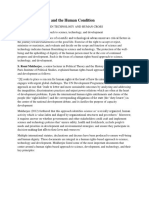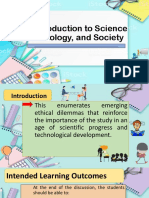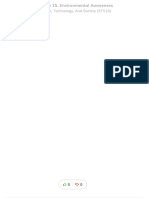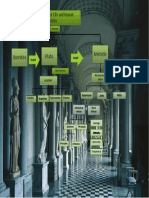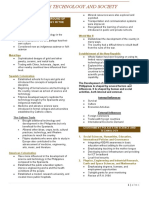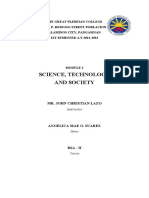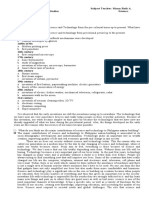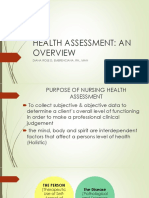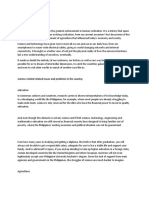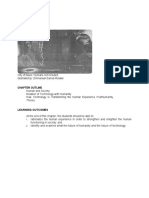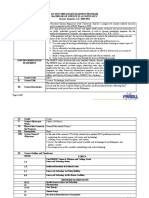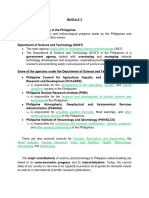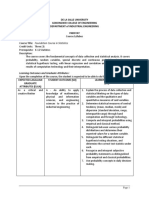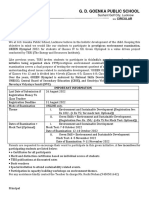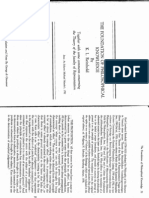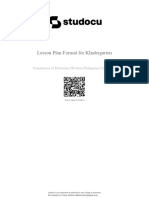0 ratings0% found this document useful (0 votes)
435 viewsSTS-Module 2
1. The document discusses the role of science and technology in nation-building in the Philippines from pre-colonial times to the present.
2. It describes how indigenous Filipinos had practices related to science and technology before Spanish colonization, including agriculture, shipbuilding, and herbal medicine. During Spanish rule, formal education was introduced and institutions like universities were established.
3. Under American rule, the public education system and infrastructure like hospitals and transportation were improved. However, World War 2 set back development. The current government is working to boost scientific and technological capabilities through education, research, and overseas partnerships.
Uploaded by
Angel Justine BernardoCopyright
© © All Rights Reserved
We take content rights seriously. If you suspect this is your content, claim it here.
Available Formats
Download as DOCX, PDF, TXT or read online on Scribd
0 ratings0% found this document useful (0 votes)
435 viewsSTS-Module 2
1. The document discusses the role of science and technology in nation-building in the Philippines from pre-colonial times to the present.
2. It describes how indigenous Filipinos had practices related to science and technology before Spanish colonization, including agriculture, shipbuilding, and herbal medicine. During Spanish rule, formal education was introduced and institutions like universities were established.
3. Under American rule, the public education system and infrastructure like hospitals and transportation were improved. However, World War 2 set back development. The current government is working to boost scientific and technological capabilities through education, research, and overseas partnerships.
Uploaded by
Angel Justine BernardoCopyright
© © All Rights Reserved
We take content rights seriously. If you suspect this is your content, claim it here.
Available Formats
Download as DOCX, PDF, TXT or read online on Scribd
You are on page 1/ 6
Module 2
SCIENCE AND TECHNOLOGY IN THE PHILIPPINES
OBJECTIVES
1. Discuss the role of science and technology in Philippine nation-building.
2. Evaluate government policies pertaining to science and technology in terms of their
contributions to nation-building.
3. Identify actual science and technology policies of the government and appraise their
impact on the development of the Filipino nation.
INTRODUCTION
This module will discuss the concept of science education and will identify some
strategies to promote science education in the country.
Science and technology in the Philippines describes scientific and techno-logical
progress made by the Philippines and analyses related policy issues. The main agency
responsible for managing science and technology (S&T) is the Department of Science
and Technology (DOST). There are also sectoral councils for Forestry, Agri-culture and
Aquaculture, the Metal Industry, Nuclear Research, Food and Nutrition, Health,
Meteorology, Volcanology and Seismology.
The Department of Science and Technology (DOST) in the Philippines is a government
agency tasked with overseeing and managing national technology
development and acquisition, undertaking technological and scientific research and
promoting public consciousness of science and technology.
The major contributions of science and technology to Philippine nation-building are
linked to its socio-economic progress and its industrialization. Today, the current state
of our country is very low in its capacity to produce local goods for domestic needs as
well as in international scientific research publications.
Brief Historical Background of Science and Technology in the Philippines
Pre- colonial period
Even before the colonization by the Spaniards in the Philippine islands, the natives of
the archipelago already had practices linked to science and technology. Filipinos were
already aware of the medicinal and therapeutic properties of plants and the methods of
extracting medicine from herbs. They already had an alphabet, number system, a
weighing and measuring system and a calendar. Filipinos were already engaged in
farming, shipbuilding, mining and weaving."
Shipbuilding showed geometric thinking and mastery of convexity, concavity, and the
proper proportion between ship breadth and length to ensure sailing efficiency. The
practice of constructing as much as twelve ships and boats to fit inside each other, not
unlike matryoshka dolls containing each other, can be interpreted as large three-
dimensional wooden demonstration of sets, subsets, volumes, and ordinality."
"The Banaue Rice Terraces are among the sophisticated products of engineering by
pre-Spanish era Filipinos. The early inhabitants of the had their own culture and
traditions. They had their own belief system and indigenous knowledge
Kept them organized and sustained their lives and communities for many
years.
Pre- colonial period:
Even before the colonization by the Spaniards in the Philippine islands, the natives of
the archipelago already had practices linked to science and technology. Filipinos were
already aware of the medicinal and therapeutic properties of plants and the methods of
extracting medicine from herbs. They already had an alphabet, number system, a
weighing and measuring system and a calendar. Filipinos were already engaged in
farming, shipbuilding, mining and weaving."
The Laguna Copperplate Inscription (key) is inscribed with small writing hammered into
its surface. It shows heavy Indian cultural influence (by way of Srivijaya) present in the
Philippines prior to European colonization in the 16th century.
"The Laguna Copperplate Inscription shows the use of mathematics in precolonial
Philippine societies. A standard system of weights and measures is demonstrated by
the use of precise measurement for gold, and familiarity with rudimentary astronomy is
shown by fixing the precise day within the month in relation to the phases of the moon.
The Laguna Copperplate Inscription (Filipino: Inskripsyon sa Binatbat na Tanso ng
Laguna, Malay: Prasasti keping tembaga Laguna; often shortened into the acronym
LCI), a legal document inscribed on a copper plate in 900 CE, is the earliest known
calendar-dated document found in the Philippines. The date of the inscription would
make it contemporary to the Balitung kingdom of Central Java, although it did not
necessarily originate from that area.
The plate was found in 1989 by a laborer near the mouth of the Lumbang River in
Wawa, Lumban, Laguna in the Philippines. The inscription, written in a mix of the Old
Malay language using the Old Kawi script, was first deciphered by Dutch anthropologist
and Hanunó'o script expert Antoon Postma in 1992.
The LCI documents the existence of several early Philippine polities as early as AD 900,
most notably the Pasig River delta polity of Tondo. Scholars believe that it also indicates
trade, cultural, and possibly political ties between these polities and at least one
contemporaneous Asian civilization—the Medang Kingdom of the island of Java.
The inscription was written in Kawi script—a writing system developed in Java— using a
mixture of languages including Sanskrit, Old Javanese, and Old Malay. This was a rare
trace of Javanese influence, which suggests the extent of inter insular exchanges of that
time.
SCIENCE
Planting crops that provide them food
Taking care of animals to help in their daily tasks
Food production
Interpret the movements of heavenly bodies to predict seasons and climates and
organizing months and years
Medicinal uses of plants
TECHNOLOGY
Building houses
Irrigation systems
Developing tools
Musical instruments
METAL AGE INFLUENCE
Sophisticated designs of gold and silver jewelry, ceramics and metal tools.
Trading with other countries like China, Indonesia and Japan.
All these practices in S & T are known as Indigenous or Folk Science
Spanish Colonial Period
The colonization of the Philippines contributed to growth of science and technology in
the archipelago. The Spanish introduced formal education and founded scientific
institution. During the early years of Spanish rule in the Philippines. Parish schools were
established where religion, reading, writing, arithmetic and music was taught. Sanitation
and more advanced methods of agriculture was taught to the natives. Later the Spanish
established colleges and universities in the archipelago including the University of Santo
Tomas."
Spanish Rule
Spaniards brought their own culture and practices
Established schools and introduced the concepts of subjects and disciplines
Learning of science in school focuses on understanding different concepts
related to the human body, plants, animals and bodies.
Technology focuses on using and developing house tools in everyday life.
Life during the Spanish era
Life became modernized, adapting some western technology and ways of life.
Filipinos replicated technology brought by the Spaniards using indigenous
materials.
Medicine and advanced science were introduced in formal colleges and
universities.
GALLEON TRADE
The galleon trade was supplied by merchants largely from port areas of Fujian
who traveled to Manila to sell the Spaniards spices, porcelain, ivory, processed
silk cloth and other valuable commodities.
From 1565 to 1815, the galleon trade contributed to the change of culture,
language and environment for both Philippines and Mexico.
The Galleon Trade was a government monopoly. Only two galleons were used:
One sailed from Acapulco to Manila with some 500,000 pesos worth of goods,
spending 120 days at sea; the other sailed from Manila to Acapulco with some
250,000 pesos worth of goods spending 90 days at sea.
The country became one of the centers of global trade in SEA and was
considered one of the most developed places in the region.
Superstitious beliefs and Catholic doctrines and practices halted the growth of
science in the country.
AMERICAN PERIOD
The Americans have more influence in the Development of S&T compared to the
Spaniards. They established the public education system, improved engineering works
and health conditions of the people. They established a modern research university, the
University of the Philippines and also created more public hospitals. The mineral
resources were explored and exploited, transportation and communication systems
were improved, though not accessible throughout the country.
The Americans did everything to “Americanize” the Filipinos. They reorganized the
learning of Science and introduced it in public and private schools.
In basic education, science education focused on nature studies and science and
sanitation. The teaching of science in higher education has greatly improved and
modernized.
WORLD WAR II
World War II has destabilized the development of the country in many ways. Institutions
and public facilities were turned into ashes, houses were burned, and many lives
destroyed. The country had a difficult time to rebuild itself from the ruins of the war. The
human spirit to survive and to rebuild the country may be strong but the capacity of the
country to bring back what was destroyed was limited.
Establishment of the New Republic
The new nation started focusing on using its limited resources in improving S&T
capability.
Use of Overseas Development Allocation to improve scientific productivity and
technological capability.
Human resource development focused on producing more engineers, scientists,
technology experts, doctors, and other professionals.
INFLUENCES IN THE DEVELOPMENT OF S & T IN THE PHILIPPINES
Science and technology may have significant impact on the lives of the people and in
the development of Philippine society. However, improving the quality of science
education still remains as a big challenge in the country. School science from basic
education to graduate education is improving slowly, and there are only a few students
enrolling in science and technology courses.
GOVERNMENT POLICIES ON SCIENCE AND TECHNOLOGY
Introduced and implemented programs, projects and policies to boost science
and technology.
GOAL: prepare the whole country and its people to meet the demands of a
technologically driven world and capacitate the people to live in a world
driven by science.
In response to the ASEAN 2015 Agenda, the government, particularly the DOST,
has sought the expertise of the NCRP to consult various sectors in the society to
study how the Philippines can prepare itself in meeting the ASEAN 2015 goals.
The NRCP clustered these policies into four:
1. Social Sciences, Humanities, Education, International Policies and Governance
Integrating ASEAN awareness in basic education without adding to the
curriculum
Emphasizing teaching in the mother tongue
Developing school infrastructure and providing for ICT broadband
Local food security
2. Physics, Engineering, and Industrial Research, Earth and Space Sciences, and
Mathematics
Emphasizing degrees, licenses, and employment opportunities
Outright grants for peer monitoring
Review of RA 9184
Harnessing science and technology as an independent mover of development
3. Medical, Chemical and Pharmaceutical Sciences
Ensuring compliance of drug-manufacturing firms with ASEAN-harmonized
standards by full implementation of the FDA
Creating an education council dedicated to standardization of pharmaceutical
services and care
Empowering food and drug agencies to conduct evidence-based research as
pool of information
Allocating 2% of the GDP to research
Legislating a law supporting human genome projects
4. Biological Sciences, Agriculture, and Forestry
Protecting and conserving biodiversity by full implementation of existing laws
Use of biosafety and standard model by ASEAN countries
Promoting indigenous knowledge systems and indigenous people’s conservation
Formulation of common food and safety standards
You might also like
- Au Contraire Figuring Out The French PDFNo ratings yetAu Contraire Figuring Out The French PDF330 pages
- Serafica - Chapter 1 Lesson 1 Intellectual Revolutions That Defined Society100% (1)Serafica - Chapter 1 Lesson 1 Intellectual Revolutions That Defined Society22 pages
- Chapter 3 Intellectual Revolutions That Defined Society STS100% (3)Chapter 3 Intellectual Revolutions That Defined Society STS40 pages
- Biotechnology: Science, Technology and SocietyNo ratings yetBiotechnology: Science, Technology and Society34 pages
- CSTS Lesson 1 - Introduction To Science, Technology and Society100% (2)CSTS Lesson 1 - Introduction To Science, Technology and Society26 pages
- Sts 101 - Introduction To Science, Technology and SocietyNo ratings yetSts 101 - Introduction To Science, Technology and Society19 pages
- Topic 8: Information Age: Learning ObjectivesNo ratings yetTopic 8: Information Age: Learning Objectives6 pages
- Chapter 2: Historical Antecedents of Science and Intellectual Revolutions That Defined SocietyNo ratings yetChapter 2: Historical Antecedents of Science and Intellectual Revolutions That Defined Society27 pages
- GROUP 1 (N2BAM-3A) The Philippine Government Science & Technology Agenda100% (1)GROUP 1 (N2BAM-3A) The Philippine Government Science & Technology Agenda4 pages
- History of Science and Technology in The Philippines in Nation-Building.No ratings yetHistory of Science and Technology in The Philippines in Nation-Building.20 pages
- Module 15 Environmental Awareness CompressNo ratings yetModule 15 Environmental Awareness Compress15 pages
- Understanding The Self (GEED 10023) : Santa Rosa CampusNo ratings yetUnderstanding The Self (GEED 10023) : Santa Rosa Campus27 pages
- Point of View of Spaniards: April 27, 1521No ratings yetPoint of View of Spaniards: April 27, 15215 pages
- Major Personalities in Science and Technology in The Philippines 2100% (1)Major Personalities in Science and Technology in The Philippines 28 pages
- Science, Technology and Nation Building 1 PDFNo ratings yetScience, Technology and Nation Building 1 PDF25 pages
- The LEAP of Science and Technology During The Scientific Revolution (A.D. 1600-A.D. 1700)No ratings yetThe LEAP of Science and Technology During The Scientific Revolution (A.D. 1600-A.D. 1700)14 pages
- Module 1 Section 3: Intellectual Revolutions and SocietyNo ratings yetModule 1 Section 3: Intellectual Revolutions and Society5 pages
- Lesson 5 - The Philippine Government Science and Technology Agenda100% (1)Lesson 5 - The Philippine Government Science and Technology Agenda17 pages
- Lesson 3: Exercises Questions For ReflectionNo ratings yetLesson 3: Exercises Questions For Reflection2 pages
- Health Assessment: An: Diana Rose D. Emerenciana, RN., ManNo ratings yetHealth Assessment: An: Diana Rose D. Emerenciana, RN., Man72 pages
- Science-Related Related Issues and Problems in The CountryNo ratings yetScience-Related Related Issues and Problems in The Country3 pages
- Gec 7 Science Technology and Society CabaNo ratings yetGec 7 Science Technology and Society Caba8 pages
- Intellectual Revolutions That Defined Society0% (1)Intellectual Revolutions That Defined Society28 pages
- Module 2 Science and Technology in The PhilippinesNo ratings yetModule 2 Science and Technology in The Philippines12 pages
- Week 5 (: Philosophical Foundations of Business EthicsNo ratings yetWeek 5 (: Philosophical Foundations of Business Ethics7 pages
- Definition and Basic Concepts of Ethics: Learning ObjectivesNo ratings yetDefinition and Basic Concepts of Ethics: Learning Objectives3 pages
- Acctg. Ed 1 - Unit2 Module 7 Posting To Ledger50% (2)Acctg. Ed 1 - Unit2 Module 7 Posting To Ledger16 pages
- Acctg. Ed 1 - Unit2 Module 6 Business Transactions and Their AnalysisNo ratings yetAcctg. Ed 1 - Unit2 Module 6 Business Transactions and Their Analysis29 pages
- Acctg. Ed 1 - Unit2 Module 5 Books of Accounts and Double-Entry SystemNo ratings yetAcctg. Ed 1 - Unit2 Module 5 Books of Accounts and Double-Entry System15 pages
- UNP Research Journal, Vol. XXIV January - December 2015 ISSN 0119-3058No ratings yetUNP Research Journal, Vol. XXIV January - December 2015 ISSN 0119-305814 pages
- CNMI Public School System Student Portal Program Fall 2024 Parent Guardian Consent FormNo ratings yetCNMI Public School System Student Portal Program Fall 2024 Parent Guardian Consent Form1 page
- De La Salle University Gokongwei College of Engineering Department of Industrial Engineering FndstatNo ratings yetDe La Salle University Gokongwei College of Engineering Department of Industrial Engineering Fndstat5 pages
- Youssra Elouaer Recommendation Letter INSAT CHEMISTRYNo ratings yetYoussra Elouaer Recommendation Letter INSAT CHEMISTRY2 pages
- St. Peter Velle Technical Training Center Inc. No.: Email Add: Office Tel No.: 709-6283/366-5576No ratings yetSt. Peter Velle Technical Training Center Inc. No.: Email Add: Office Tel No.: 709-6283/366-557616 pages
- maths-class-vi-session-ending-exam-sample-paper-02No ratings yetmaths-class-vi-session-ending-exam-sample-paper-024 pages
- EIT - GTE Assessment Form1 Sohaib AshrafNo ratings yetEIT - GTE Assessment Form1 Sohaib Ashraf2 pages
- Name: Kani Naina Mohammed J K MOBILE NO: +918608433002No ratings yetName: Kani Naina Mohammed J K MOBILE NO: +9186084330023 pages
- The Great Mental Models General Thinking Concepts Shane Parrish pdf downloadNo ratings yetThe Great Mental Models General Thinking Concepts Shane Parrish pdf download88 pages
- Reinhold - The Foundations of Philosophical KnowledgeNo ratings yetReinhold - The Foundations of Philosophical Knowledge26 pages








